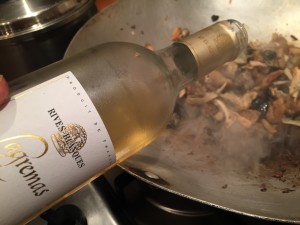Friday 2 November
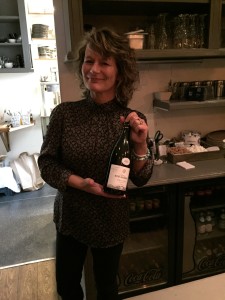 Mother and son set off to Holland, first stop Breda, a pretty small town in the south of the country, there to meet up with the owner of Dames Pellens, one of the trendy little restaurants in its historic centre.
Mother and son set off to Holland, first stop Breda, a pretty small town in the south of the country, there to meet up with the owner of Dames Pellens, one of the trendy little restaurants in its historic centre.
We walk in and stumble on the wife of the Chef, pouring a bottle of Odyssée for the table next to ours. What a great welcome!
Johan, the owner and father of the Chef, knows a lot about wine and enjoys it. His son knows a lot about food and enjoys it. This is a great father and son act. It’s exactly the sort of the place, and they are exactly the sort of people, who make our hearts lift.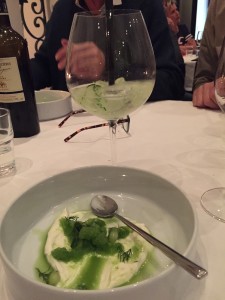
Dinner ends with a most wonderfully fresh yoghurt and cucumber concoction paired with a gin and tonic, amazingly, which I plan to plagiarise unashamedly just as soon as I can, but already know in the depths of my heart, am unable to.
Saturday 3 November
On the two of us go to Leon Colaris, for their annual Open Door Day in the South of Holland, importers we have been working with for about 17 years. They’re also the kind of people we really enjoy working with, and today is definitely a high point on the calendar – though one I have missed out on for the past four years or so.
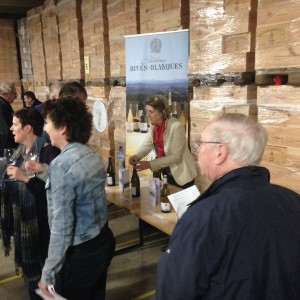 “Where’s your husband?” the visitors all ask, followed by “well, tell him we hope to see him next year” …
“Where’s your husband?” the visitors all ask, followed by “well, tell him we hope to see him next year” …
Oh well.
Halfway through this two day event, the producers meet up for dinner with the Colaris team in the private tasting room, where an open fire blazes. To coin a phrase – (a Dutch one) – it is very gezellig. These wine tasting events are always great fun, but the best part is often this: relaxing when the energy has seeped out of the day, and talking to producers from other regions and other countries.
The fellow from Beaujolais sitting next to me laments the plight of Beaujolais wines. How can that be, I ask? Beaujolais is so well known (unlike Limoux)!
Oh yes, he says, ask the proverbial taxi driver in New York if he has heard of Romanée Conti, and they won’t have a clue. But have they heard of Beaujolais? Mais, oui! Everyone’s heard of Beaujolais! The whole world over! And no one is prepared to pay proper money for Beaujolais that goes beyond the Beaujolais Nouveau…
Interesting thought, I think: how even if you have names that are universally known, such as Bordeaux or Beaujolais on your label, it doesn’t help an inch if you happen to be in Entre Deux Mers or if you are tainted by the fun and fame of Beaujolais Nouveau. You may as well be making a wine as universally unknown as Limoux, in fact, you might even be better off.
Saturday November 10
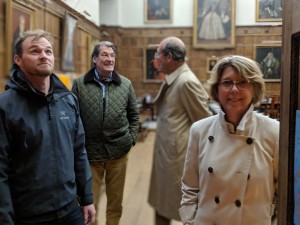 Clever is the daughter of a winegrower who wins a full academic scholarship paid for by a pub!
Clever is the daughter of a winegrower who wins a full academic scholarship paid for by a pub!
One of our first stops in Oxford, as usual, on this get-away weekend break, is a cosy pub called the Lamb & Flag, who are Xaxa’s official sponsors, right next door to St John’s College, where Xaxa is doing her DPhil. (or rather, finishing it off, we hope). We couldn’t possibly come and go without showing at least raising a glass in gratitude.
We traipse around the Colleges of St John’s and son-in-law’s Jesus College, quietly amazed and impressed, like all the other visiting parents trooping behind their kids, at what our off-spring have managed to achieve, how they managed to do it, and what an incredible stage built by centuries and generations of great thinkers, they have inherited to play those 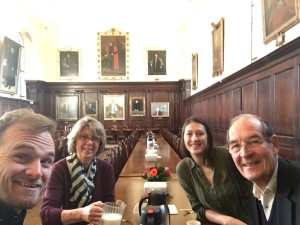 achievements out on. And this is only the beginning. These particular parents were so silenced by it all, that they completely forgot about their main mission in life, to make and sell wine. Didn’t even try to flog our bottles at the Lamb & Flag, an unthinkable oversight …
achievements out on. And this is only the beginning. These particular parents were so silenced by it all, that they completely forgot about their main mission in life, to make and sell wine. Didn’t even try to flog our bottles at the Lamb & Flag, an unthinkable oversight …
But then this place inspires many and awes just about everyone, which was probably its intention all along. They say there isn’t another like it, excepting – grudgingly – perhaps Cambridge
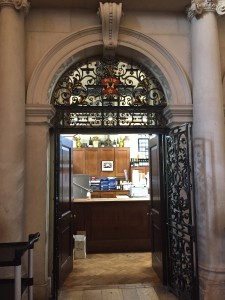 Even the door to the kitchen at St John’s is from another world.
Even the door to the kitchen at St John’s is from another world.
(As is the breakfast coming through it, for which we sit, primed and panting, the first in the queue, as the hands of the clock inches toward 9 a.m.)
Wednesday November 14
Michèle, our neighbour, phones in heightened excitement. She is walking though some of our woodland with her friend, the great mushroom expert. They have stumbled across a treasure trove of mushrooms. “An absolute treasure trove” she repeats, bellowing down the phone, “you must come immediately! Those delicious little grey ones everywhere. Delicious! Come now!!”
But I can’t. My priorities chain me to the desk right now. Stupid me.
Can you ever have enough mushrooms?
Never seen so many: between the vines, under the olive trees, around the pines, underfoot everywhere.
Tread softly, for you tread on my mushrooms …
Answer: yes, maybe you can. We’re eating them for breakfast, lunch and dinner: raw, cooked, casseroled, fried and steamed.
And drying them and freezing them.
Sunday November 18
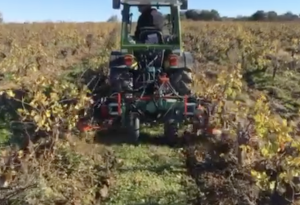 Driving a tractor up and down rows of vines with an intercep behind it might not be everyone’s idea of an ideal Sunday outing. Walking behind said tractor with an intercep hitched to it, up and down rows of vines might be even less everyone’s idea of an ideal Sunday outing. But here today are two happy men, the one driving, the other walking behind, as we test out a new machine for mechanically limiting the weeds between the vines.
Driving a tractor up and down rows of vines with an intercep behind it might not be everyone’s idea of an ideal Sunday outing. Walking behind said tractor with an intercep hitched to it, up and down rows of vines might be even less everyone’s idea of an ideal Sunday outing. But here today are two happy men, the one driving, the other walking behind, as we test out a new machine for mechanically limiting the weeds between the vines.
Not every one’s idea of a great Sunday outing, but for these two guys this is poetry in motion.
Wednesday 21 November
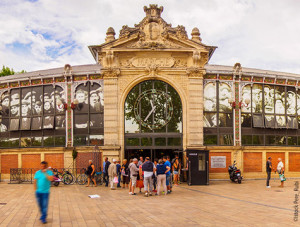 The Vnifilles, a group of Languedoc’s female winegrowers, are really most loveable. In fact, they are loveable to bits. As demonstrated by the owner of the little wine-bar we’re having lunch at, in Narbonne’s 19thcentury covered market. Drawn in by the laughter, the talking, eating, and sometimes almost crying, at our table, he sidles up ever closer and ends up perched on the edge of it, inviting us to taste the newest acquisitions to his range of over 100 wines, and to send him samples of our own. “You won’t forget my name,” he says (rightly), “it’s the word “tarif” reversed.”
The Vnifilles, a group of Languedoc’s female winegrowers, are really most loveable. In fact, they are loveable to bits. As demonstrated by the owner of the little wine-bar we’re having lunch at, in Narbonne’s 19thcentury covered market. Drawn in by the laughter, the talking, eating, and sometimes almost crying, at our table, he sidles up ever closer and ends up perched on the edge of it, inviting us to taste the newest acquisitions to his range of over 100 wines, and to send him samples of our own. “You won’t forget my name,” he says (rightly), “it’s the word “tarif” reversed.”
(Monsieur Firat, be warned: you will undoubtedly be hearing from us …)
Les Halles is a marvel of 19thcentury architecture “in the style of Baltard”, which to the uneducated eye, doesn’t look much different from Eiffel, with its embellished iron pillars and glass roof. The idea of endowing Narbonne with a proper covered market first came up in 1871, but it took them another 27 years to actually get going on the project. And when finally up and ready to run, the local notables and votables of the administrative and bureaucratic sector stepped in and said, in the time-honoured manner, that there was a little question of “non-conformity” to be dealt with first. So the doors to this “most beautiful and functional” of French covered markets did not open until 1901, a full 30 years after the idea first saw the light of day.
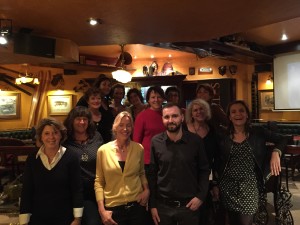 And now they close behind us, as we leave the rugby playing owner of the market restaurant Chez Bebelle throwing his sausages around like a rugby ball, the vendors vending their fruit and vegetables, and Monsieur tariF sweeping up after his last customers, and head for Languedoc’s Conseil Interprofessionel right next door.
And now they close behind us, as we leave the rugby playing owner of the market restaurant Chez Bebelle throwing his sausages around like a rugby ball, the vendors vending their fruit and vegetables, and Monsieur tariF sweeping up after his last customers, and head for Languedoc’s Conseil Interprofessionel right next door.
These are the guys who promote Languedoc’s wines, and they have lent us one of their rooms for a Vinifilles meeting. The wholly admirable Mme Miren Lorgeril, fellow winegrower and grandee of the Cabardès region, is the President, and comes in to say hello. Dangerous thing to do, when there may be a couple of Vinifilles lurking in there with an axe to grind about how their appellation it being treated by the organisation.
And then on with undiminished spirit to the curiously named Private Bowling Pub, which turns out to be exactly what it says it is: a pub. And adjacent to a bowling alley, to boot. And here we are for reasons not entirely clear to many of us, pouring our wines for people who have dropped in to taste them. It is extremely jolly, and the pub is a real pub, the sort of pup that makes a pub-going person feel completely at home.
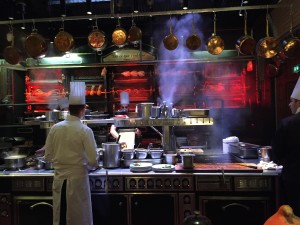 We finish off having dinner in the restaurant upstairs owned by the same people, called Les Grands Buffets. This, par contre, is a proper French brasserie – but a brasserie unlike any I have ever seen. Pristine white tablecloths and embroidered napkins. Mirrors everywhere. Hand-made replicas of Louis 16 dining chairs. Silverware and artworks in every cabinet. 120 staff, including 4 pastry chefs. Some 80 wines served by the glass – attentively by a beautifully bearded sommelier. From 300 to 1000 covers a day. Yes, 300 – 1000. Buffets of lobster, langoustine, oysters, salmon … buffets of foie gras made in any way
We finish off having dinner in the restaurant upstairs owned by the same people, called Les Grands Buffets. This, par contre, is a proper French brasserie – but a brasserie unlike any I have ever seen. Pristine white tablecloths and embroidered napkins. Mirrors everywhere. Hand-made replicas of Louis 16 dining chairs. Silverware and artworks in every cabinet. 120 staff, including 4 pastry chefs. Some 80 wines served by the glass – attentively by a beautifully bearded sommelier. From 300 to 1000 covers a day. Yes, 300 – 1000. Buffets of lobster, langoustine, oysters, salmon … buffets of foie gras made in any way 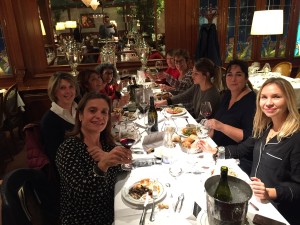 you want … buffets of local delicacies, which may not be absolutely everyone’s cup of tea – such as frogs legs, tripe, veal head, snails … grills of suckling pig, wild fish, meat of every shape and size … buffets of cheese chosen by the Meilleur Ouvrier de France … and now, now let’s attack the work of those four pastry chefs. Oh, and don’t forget the chocolate fountain
you want … buffets of local delicacies, which may not be absolutely everyone’s cup of tea – such as frogs legs, tripe, veal head, snails … grills of suckling pig, wild fish, meat of every shape and size … buffets of cheese chosen by the Meilleur Ouvrier de France … and now, now let’s attack the work of those four pastry chefs. Oh, and don’t forget the chocolate fountain
It’s actually quite incredible.
Fellow Vinifille Francoise and I drive back to Limoux after midnight, passing roadblocks set up by the gilets jaune, a people’s movement revolting against increased taxes on petrol, and are reminded that life goes on outside the bubble of this highly unusual work day.
Saturday 24 November
Michèle’s mother stomps into the kitchen with an enormous plastic bag full of mushrooms.
“For you!” she shouts, “take them!”
There’s no arguing with Michele’s mother. And the mushrooms are very fresh and very beautiful. And very plentiful.
Monday November 26
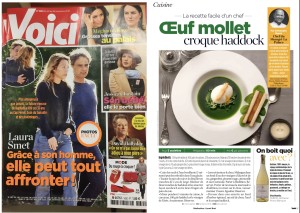 Too much food! But even so, hats off to France’s high-circulation Voici magazine for getting the Chef of the Shangri-lah hotel to come up with the perfect recipe to accompany our mauzac: an egg, spinach and fish combination that would kill most wines but will certainly shine with Occitania.
Too much food! But even so, hats off to France’s high-circulation Voici magazine for getting the Chef of the Shangri-lah hotel to come up with the perfect recipe to accompany our mauzac: an egg, spinach and fish combination that would kill most wines but will certainly shine with Occitania.
Easy enough even for the humble cook at Rives-Blanques to reproduce.
But there’s been altogether enough food this month. What we like most about the article is his comment “This wine swings in the mouth”.
Which is literally, word for word, what the Belgian wine critic, Frank van der Auwera, once said about it too – and we doubt that Monsieur Bret reads Flemish.
Tuesday November 27
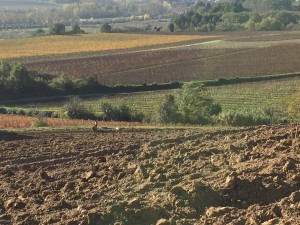 A lot of action in the field today: pre-pruning going on in the chardonnay next to the road, more housekeeping and cleaning between the vines with the intercep taking place in the field next door, and at the end of the vineyard Jan-Albe and a team of two are measuring out the old mauzac field, preparing it for the next stage in its life. Above all this, the sun shines and the sky is blue.
A lot of action in the field today: pre-pruning going on in the chardonnay next to the road, more housekeeping and cleaning between the vines with the intercep taking place in the field next door, and at the end of the vineyard Jan-Albe and a team of two are measuring out the old mauzac field, preparing it for the next stage in its life. Above all this, the sun shines and the sky is blue.
And life feels good.
Wednesday 28 November
But life’s not so good for the jovial Dutchman who navigates his huge truck up our little track and into the courtyard. He had been stopped and parked by the gilets jaunes on the roadside for 20 hours.
“20 hours!” he says loudly, “No food! No water! Just sitting there, by the roadside for twenty hours …”
And he whips out his mobile to show us hour-by-hour photos of his enforced stop. The last photo was indeed dark and street-light lit.
That’s not nice, we agree, and try to work out how he can best get to Saint-Chinian to collect his next load of wine.
Then another jovial truck driver comes in, this one from Belgian. Had he also been parked on the roadside?
“No” he said “Not that. But they won’t let you on the highway at some points, and they won’t let you off it at others.” So he, like the man who never returned under the streets of Boston, was doomed to drive up and down the motorway and then back up again before finally finding a cross-country escape route. How on earth was he going to get to Perpignan? And with that huge truck behind him?
Again we try and work out a route. His mobile’s ap shows a sea of blocked exits throughout the whole of the South of France.
Then a third one comes in, this one for wine bound for Canada, though he won’t be trucking it that distance … he’s actually trucked quite enough, he reckons, though Canada at this point probably looks like the better option. “They may have a point, these gilets jaunes,” he says, “but why don’t they blockade Monsieur Macron, instead of doing this to us?”
Every coin has three sides: heads, tails, and the bit in the middle. These guys, jovial and phlegmatic though they are, are seriously caught in the middle.
Wednesday November 28
The European Union has debated, discussed and finally decided: the amount of copper that can be used in organic viticulture will be reduced from 6 kg per ha. per year to 4 kg per ha per year, spread over seven years.
The person riding two spirited horses – President of the Federation of the French AOPs and of the Federation of European denominated wines – says that this year’s conditions have proved that “the system cannot work”.
This year, many regions and particularly the south of France, suffered mildew such has never been seen before. You can either get on top of it by blitzing the vines with chemicals, ‘soft’ or otherwise, or you buckle under and do your damnedest with copper sulphate, the only organic alternative.
If the conditions of 2018 ever repeat themselves, and if the use of copper continues to be restricted, please will whomever has a hidden trick up his sleeve to save organic viticulture please stand up?
…/to be continued next month.

